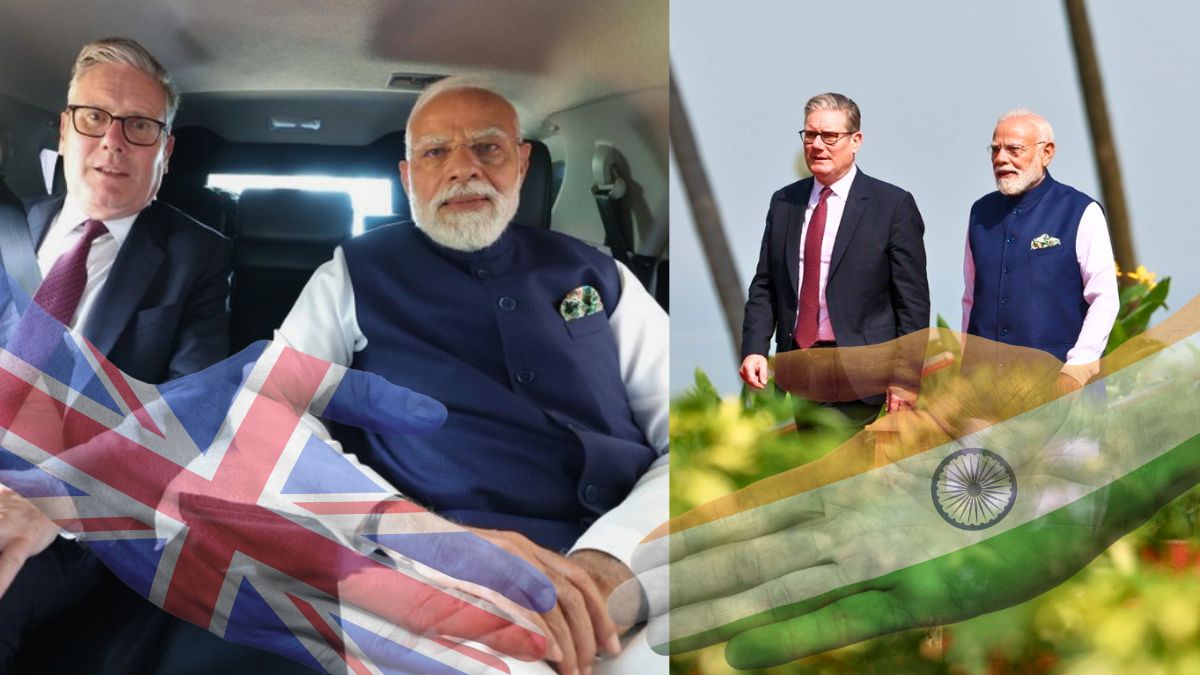India and the United Kingdom on Thursday unveiled a wide-ranging package of around 12 outcomes across key sectors, ranging from defence and education to critical minerals and climate cooperation. Among the highlights were a £350 million (₹3,900 crore) contract for lightweight multirole missiles (LMMs) from the UK.
Additionally, both the countries signed a $333 million agreement to deepen joint development of electric propulsion systems for India’s naval ships. The latest deals come just a few months after India and the United Kingdom (UK) concluded a Free Trade Agreement (FTA).
UK PM Keir Starmer, on his historic visit to India, expressed hope that the FTA could be implemented as soon as humanly possible, noting that this is the biggest deal for them since Brexit.
India-UK deals: What happened after PM Modi-Starmer meeting?
PM Modi and UK PM Starmer reaffirmed their shared commitment to harnessing frontier technologies to drive inclusive economic growth, strengthen national security, and shape the future of global innovation. Building on the landmark Technology Security Initiative (TSI), both leaders welcomed the tangible progress made across critical and emerging technologies, including telecommunications, critical minerals, AI, and health tech.
The announcements came after PM Modi met his British counterpart Starmer in Mumbai on Thursday (October 9, 2025), seeking to inject new momentum into bilateral ties following the signing of the UK–India Comprehensive Economic and Trade Agreement (CETA) earlier this year.
Why is this meeting being called a turning point?
The Mumbai meeting marked the first major follow-up to the free trade agreement signed in July at Chequers, and both leaders used the occasion to frame it as a defining moment in India–UK relations. “In times of global uncertainty, our partnership stands as a pillar of stability and progress,” Modi said, while Starmer called CETA a “breakthrough moment” that would reduce tariffs, expand market access, and create jobs.
To speed up implementation of CETA, both sides agreed to revive the Joint Economic and Trade Committee and focus on policies to boost investment and employment.
Starmer arrived with the largest-ever UK business delegation, signalling renewed confidence in India’s market. His office later said the visit secured 64 new Indian investment projects worth £1.3 billion, expected to generate nearly 7,000 jobs in the UK.
What are the key collaborations in technology, minerals, and education?
The two governments announced several technology-driven initiatives, including:
- New R&D centres for artificial intelligence and climate innovation.
- The second phase of the UK–India Critical Minerals Supply Chain Observatory, featuring a new satellite campus at IIT–ISM Dhanbad.
- A Critical Minerals Industry Guild to build supply-chain resilience for green technologies.
- Education ties also deepened, with nine UK universities approved to open campuses in India, including Lancaster University (Bengaluru) and the University of Surrey (GIFT City).
India-UK defence deal: How is the cooperation evolving?
Defence emerged as a central pillar of the new framework. India will procure lightweight multirole missiles (LMMs) from the UK under a government-to-government deal aimed at strengthening air defence capabilities, particularly in the wake of Operation Sindoor, the brief May conflict with Pakistan.
Also known as the Martlet missile, the missile is named after a mythical bird that never roosts. For the Army, it can take out threats ranging from light armoured, wheeled and tracked vehicles to aerial platforms within a distance of 6 km.
It weighs just 13 kg and has a velocity of 1.5 Mach and has been in service with the British military since 2019.
India-UK deals: What else was announced?
The joint statement by the Indian PM and UK PM also confirmed plans to:
- Establish a Regional Maritime Security Centre of Excellence (RMSCE) under the Indo-Pacific Oceans Initiative.
- Integrate Indian Air Force instructors into Royal Air Force training programmes.
- Advance collaboration on maritime electric propulsion systems for Indian naval ships.
“It’s fitting that while we meet in Mumbai, our ships are engaged in the joint naval exercise Konkan 2025,” Prime Minister Modi noted.
What steps are being taken on climate and innovation?
Both sides launched the India–UK Offshore Wind Taskforce and a Climate Technology Startup Fund, intended to support entrepreneurs and innovators working in clean tech and AI. “These initiatives reflect our shared vision for a sustainable and high-tech future,” Modi said, calling the partnership a blend of India’s dynamism and the UK’s expertise.
How big is the trade and investment picture?
At the India–UK CEO Forum, Starmer said Indian investment commitments were “just the start,” noting that in the three months since the trade deal’s signing, bilateral trade and investment rose by £6 billion. Modi expressed confidence that the two countries could double their trade volume, currently $56 billion, ahead of the 2030 target.
Did the leaders discuss geopolitical and security concerns?
Yes. The talks also covered global security issues, including the wars in West Asia and Ukraine. India raised concerns about the activities of pro-Khalistani groups in the UK and reiterated its commitment to curbing illegal migration through greater cooperation with British authorities.
Starmer’s two-day visit, his first to India as Prime Minister, appears to have reinvigorated the strategic and economic partnership between the two democracies. With new deals spanning defence, trade, green technology, and education, both sides are now positioning their alliance as a model of modern, mutually beneficial cooperation in an era of shifting global power dynamics.
